How Manchester City Enters The Final Third? Attacking Spaces by Movements
The role of the Wingers
As we recall, at Barcelona, Pep Guardiola would ask his wingers to make inverted runs in and between the channels to receive the ball behind the opposing defensive line rather than receiving it close to the byline and relying on movements from other players instead.
But at Manchester City, the scenario is slightly different.
To create appropriate depth for ball circulation on the field, the wingers have an important task of isolating the opposing fullbacks by staying high and wide. By holding position in the build up and staying wide – close to the byline, they look to stretch the opposition team and create more space in the middle for Haaland, Gündogan and de Bruyne to receive the ball.
The role of the wingers in the Man City system could be compared of the task Robben and Ribery had at Bayern Munich.
The primary objective with using inverted wingers at Manchester City by Pep Guardiola is to stretch the opposition back line by creating the width, and thereby stretch the opposition defence.
Depending on which flank the ball is on, the winger on opposite flank will stay wide to attract his marker, or at least try to direct the attention onto him, so the task for the defender becomes more uncomfortable.
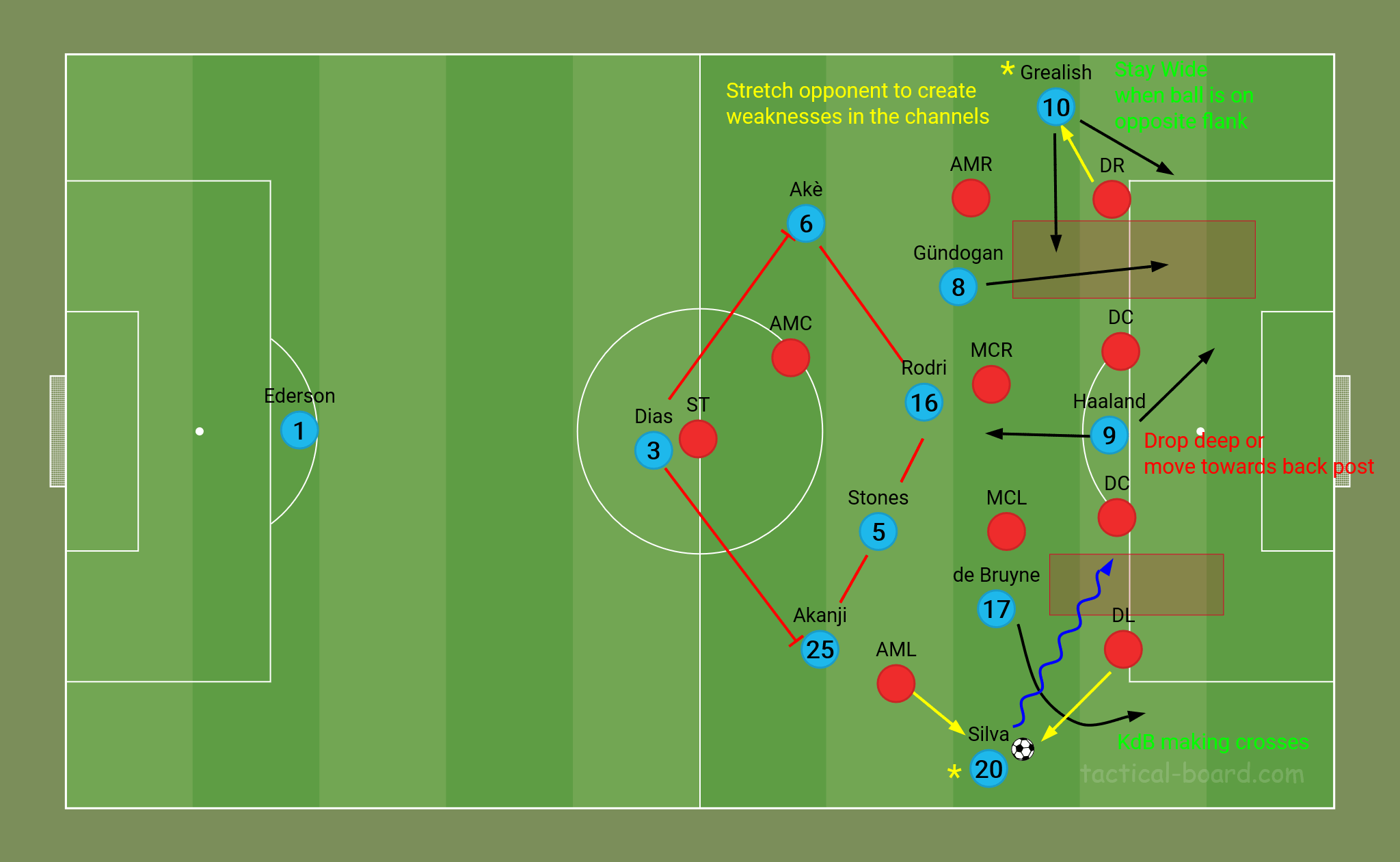
The positioning of the wingers aims at creating space in the center for Gündogan and de Bruyne to move between the channels – in the vertical space between the fullback and centre back. Basically, the idea is to set up these two players in the half space channels for them to receive the ball and either feed the striker, or come to goalscoring opportunities by taking a shot themselves.
As the team look to free up the two central attacking midfielders in the half space channels, the hope is that the opposing defensive midfielders will be dragged towards them. This creates a passing lane in the middle and basically more space in zone 14 for the striker to drop into and receive the ball. It may even make the opposition so ball-oriented that the striker can move behind the marker’s back to the opposite flank of where play is on, and attack the area behind the opposition defensive line by a clever movement something Haaland is so brilliant at!
Apart from the objective of creating width and draw the opposition on to them, the wingers look to isolate the opposing fullback in a one-on-one situation where they have qualitative superiority, they got multiple opportunities to cause havoc to the opposition’s defensive organization.
When carrying the ball, the wingers would use cut inside dribbling their way towards the middle of the pitch where they are able to combine better with their teammates. When cutting inside, it aims to destabilize the defensive block as players are slightly dragged out of position. One player has to follow the run, right?!
When the opposing marker comes out to close down the player on the ball, it leaves a gap behind him that the central midfielders and the striker can run into. At the same time, these dribbles gives teammates the time to make purposeful movements into channels.
Wingers in possession
With the qualities of Grealish and Bernardo – two highly press-resistant players but with slightly different skills – Manchester City could also use the wingers as a way to enter the final third by letting them try to beat their marker with progressive carries, or progressive passes.
When looking closer to the player’s statistics, it was often the responsibilities of Grealish to use his dribbling skills to try to break through the opposition lines with a progressive carry. So far this season he has 6.33 carries into the final third per 90 minute*, meanwhile Bernardo Silva has 3.77/90 minute.
Kevin de Bruyne on the other hand is the player with the second highest carries into the final third with 2.99/90 minute, if you were curious.
* Stats as of 29.04.2023
What’s interesting when looking at the inverted wingers in possession statistics is the few crosses they made. So far this season, both Silva and Grealish has only made 0.4 crosses per game, whilst Mahrez has 0.8 crosses per game.
This reveals how a system without attacking fullbacks have forced Manchester City to rely on the vision of the two central midfielders to first and foremost create goal scoring opportunities with Kevin de Bruyne the most important player.
Against the low block
Since his Barcelona days, the attacking patterns to overload the opposition with movements and breaking through the channels have remained. Earlier it was attacking fullbacks who overlapped on the flank to create numerical superiority in the final third with a front 3 becoming a front five.
This resulted in teams defending deeper and deeper to create a compact defensive block that’s hard to penetrate. With less space to move in, creating chances against the low block became harder and harder. Adjustments where needed.
With the 2-3-2-3, or the 3-2-2-3 shape, Pep Guardiola has perfected Manchester City’s way of playing against the low block.
One of the measures taken was to instruct the wingers to stay high and wide. By really stretching the opposition defensive line, it created a dilemma for the opposition. Either concede space on the flanks which the wingers can get space and time to receive and gain control of the ball, or defend wider but concede space in between the channels, which the central attacking midfielders can take advantage of.
As mentioned earlier, the new 3-2-4-1, or the 3-2-2-3 shape gives the perfect foundation for creating an extra man and thereby an overload around the ball zone.
The key against the low block is to have a number of strings to play on. One of them is how the two double pivots operates. Even though they act like a safety net for the team in possession, as they are able to retain possession or pick up loose balls, their positioning enables them to lure the opposition out of their defensive block.
What’s notable is their angle in relationship to the wingers and attacking midfielders. Always available to progress the ball from one flank to the other to move the opposition side to side. If Manchester City is not able to break through the lines on one flank, a diagonal back pass is available to either Rodri or Stones who can switch the ball to the opposite flank.
At the same time, Pep Guardiola has used a lot of effort to try to get Haaland more involved in the game. From a typical attacking pressing forward who looks to run behind the defensive line in his Borussia Dortmund days, Pep has instructed Haaland to come deep to get the ball, rather than sitting on the opposing markers shoulder.
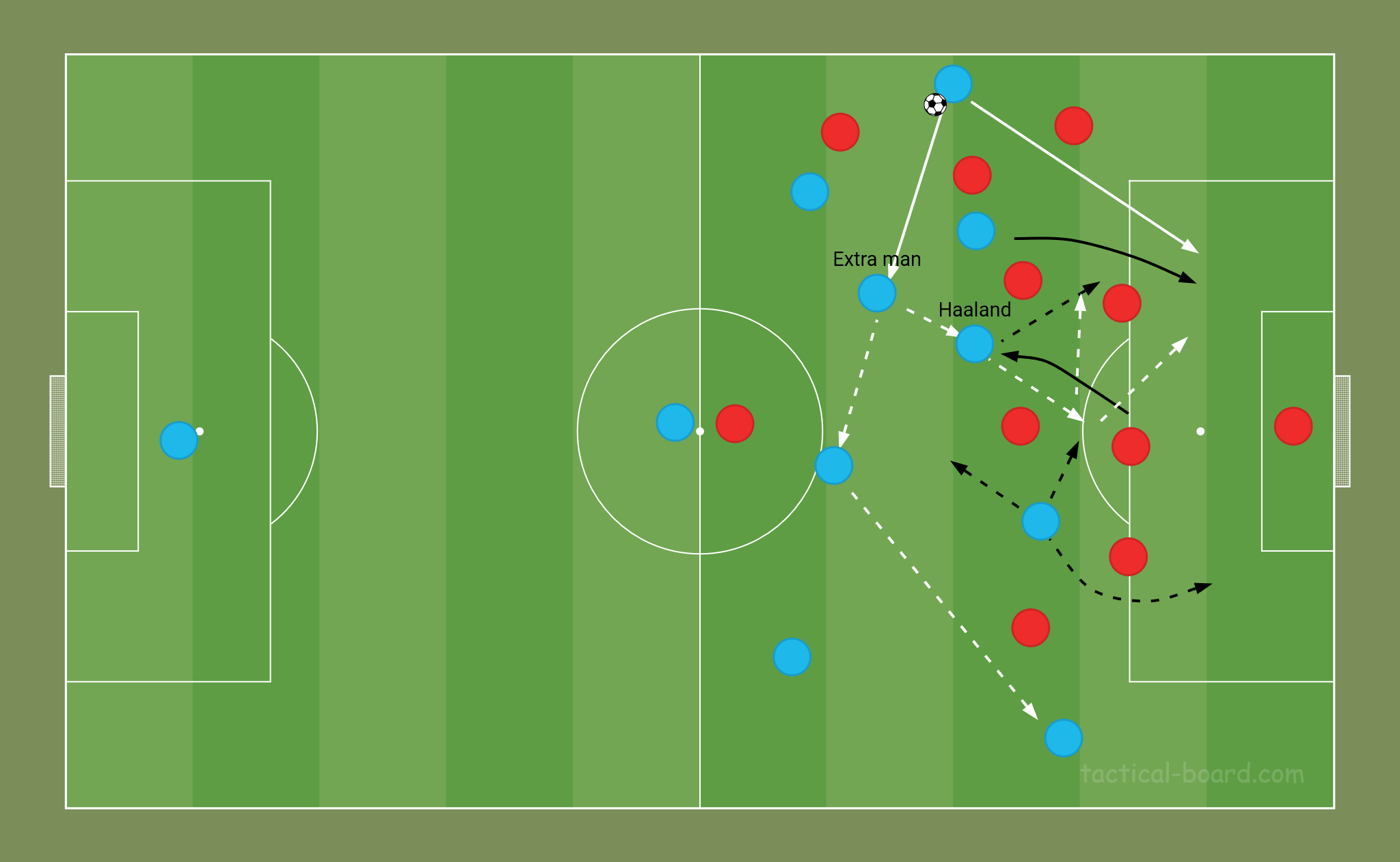
By asking the forward to drop deep, like a False 9 or Deep-lying forward, it aims to create gaps in the opposition defensive structure to penetrate in. With all those movements in the center of the pitch, where the opposition aims to defend, Manchester City can use third man runs and quick short passes and through balls as an element to move the opposition by enticing them to close down the player with the ball while other players move behind their back.
The Duties of the Attacking Midfielders in Manchester City’s 3-2-4-1 System
Traditionally, Pep Guardiola favors wingers with opposite strongest foot of the flank they are playing on. This enables the player to receive and put pressure on the opposing marker quicker by moving inwards to combine.
When receiving the ball, they could lay it off to one of the teammates that arrives from deep with either an overlapping or underlapping run to beat the press against him, or make progressive carries by cutting inside towards the middle of the pitch.
In Manchester City’s 3-2-4-1 system, there were mainly underlapping runs coming from the two number number eights: Gündogan or de Bruyne. Even though they always looked to find pockets of spaces to make themselves available, the player furthest away would look to make penetrating third man runs in between the channels which the wingers could look for in order to enter the final third.
As the inverted wingers cuts inside with the ball and dribble the ball directly towards the opposing marker, Manchester City under Pep Guardiola relies on lots of opposite movements and third man runs.
Without wingbacks, the roles of the attacking midfielders becomes essentially more important.
When one of the wingers received the ball, it was a signal for the opposing central midfielder to make movements into the channel providing more space for the winger to either make diagonal movements with the ball towards the center, lay it off to a player who can switch the point of attack, or make quick one-two’s with the attacking midfielder underlapping him.
The attacking midfielders would normally roam between the lines in a typical 2-3-2-3 / 3-2-2-3 shape where each player looked to utilize the space outside the opposing defensive midfielders.
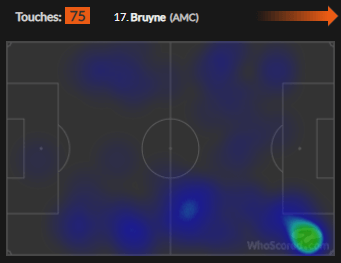
What we would often see on the left flank, was the opposite movement from Silva and de Bruyne. When Silva made an inverted run with the ball, de Bruyne moved wide towards the flank much like an attacking Mezzala, as this heat map from the Champions League match versus RB Leipzig shows us. This was the first event, to my knowledge Pep Guardiola tried the 3-2-4-1 system and it resulted in a 7-0 win and progress to quarter finals.
The duties of Kevin de Bruyne has become more and more attacking over the following matches. At times he’s played more like a second forward than a traditional midfielder. How he operates has some clear advantages both in and out of possession, something we will discover more in the section about Manchester City out of possession.
Anyway, when the team was in possession the roaming of Kevin de Bruyne between the lines gave the team a free man to distract the man-marking pressing of the opposition. If one of the opposing markers tracked him, it would leave space for another to take advantage of.
Kevin de Bruyne was often seen roaming in the area between the defenders and defensive midfielders from side to side in the attacking third to offer an additional passing option.
When receiving the ball, de Bruyne could either run with the ball, make through balls towards the opposite side of the pitch, or combine with Haaland or Silva. As the pass map from the Bayern Munich game illustrates, he would have the option to lay the ball off to Rodri who could switch the ball to Gündogan who had the opportunity to advance play to Grealish or back to where the ball came from.
On the ball, de Bruyne would often look to make crosses towards the far post where Haaland had tracked towards. This season, de Bruyne has made 211 crosses – the most crosses in the team and fourth most crosses in the Premier League – only five fewer than Trent Alexander-Arnold.
His attacking attitude with the ball has seen the player making the 5th most crosses into the penalty box in Premier League. This has resulted in 16 assists and a total of 90 key passes when there’s five matches yet to play. That’s an assist every 64th minute!
On the right flank, Gündogan tended to be more disciplined with his forward movements. It all depending on who had the ball and where. If Akanji had the ball on the right hand flank, Gündogan would make penetrating runs in behind the opposing defensive line. If Grealish had the ball, he would stay in cover or come to support to provide passing option and an outlet for the team to progress play into the final third with combination play.
From time to time, Gündogan and de Bruyne would switch positions to further distract and beat the opposing man-marking system. This is somthing we saw in the match against Liverpool where de Bruyne and Grealish combined with great combination play, and where the inverted wingers moved into channels instead of the central attacking midfielders.
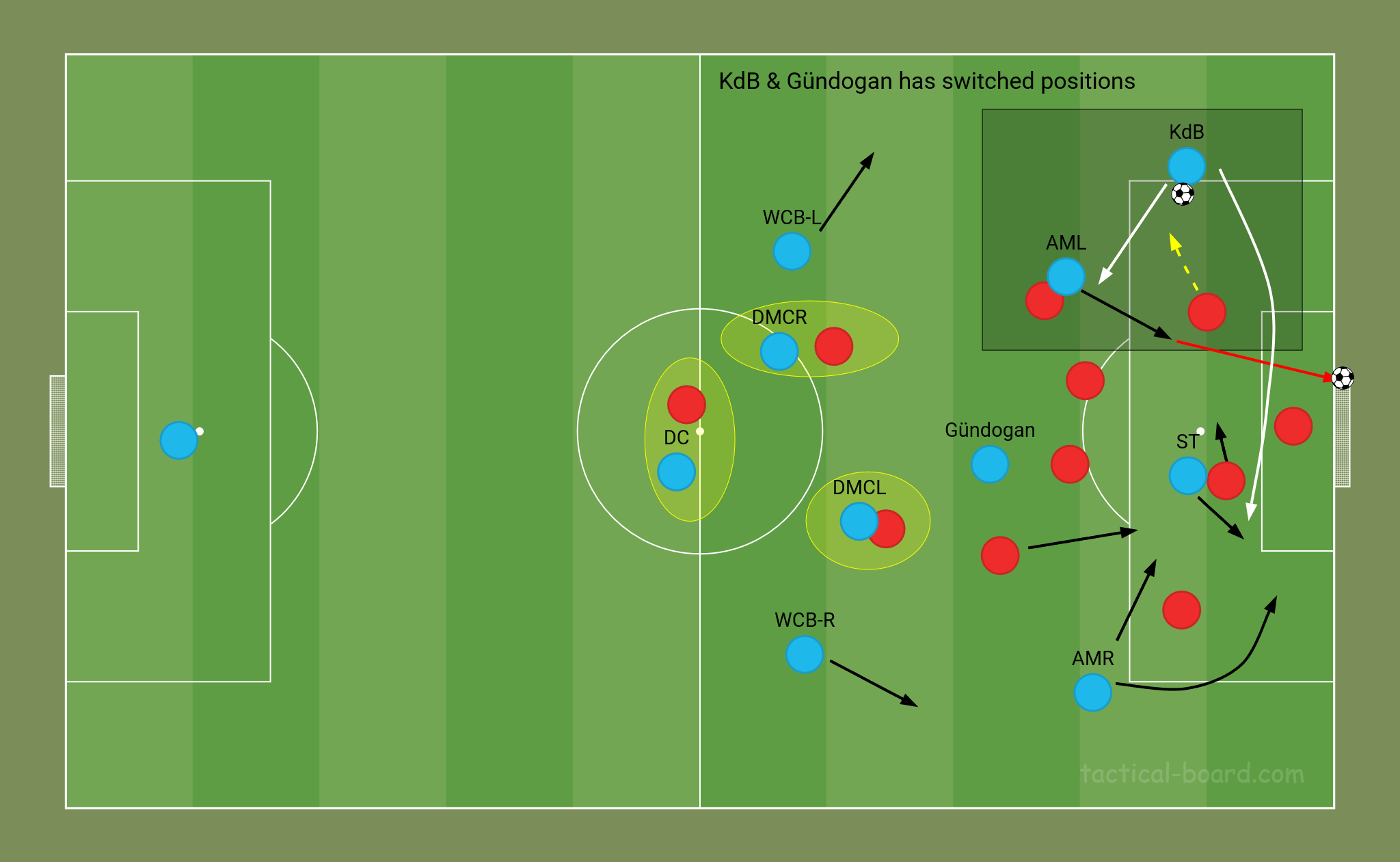
Regardless of their positioning, the attacking patterns of play when Manchester City enters final third looks to create numerical advantage and overloads in specific zones on the pitch. Their passing patterns look to create an extra man in possession to beat the press. In Pep Guardiola’s system, the structure of the 3-2-5 meant that one of the four midfielders got the opportunity to become the extra man.
While Stones could be described as the extra man in the first sequences of the build-up, Kevin de Bruyne would act like a free man in the final third.
As he roamed between the lines and looked to find pocket of spaces to receive the ball, how the rest of the team behaved with the ball at their feet was of importance to whether Man city could work the ball into a goalscoring opportunity.
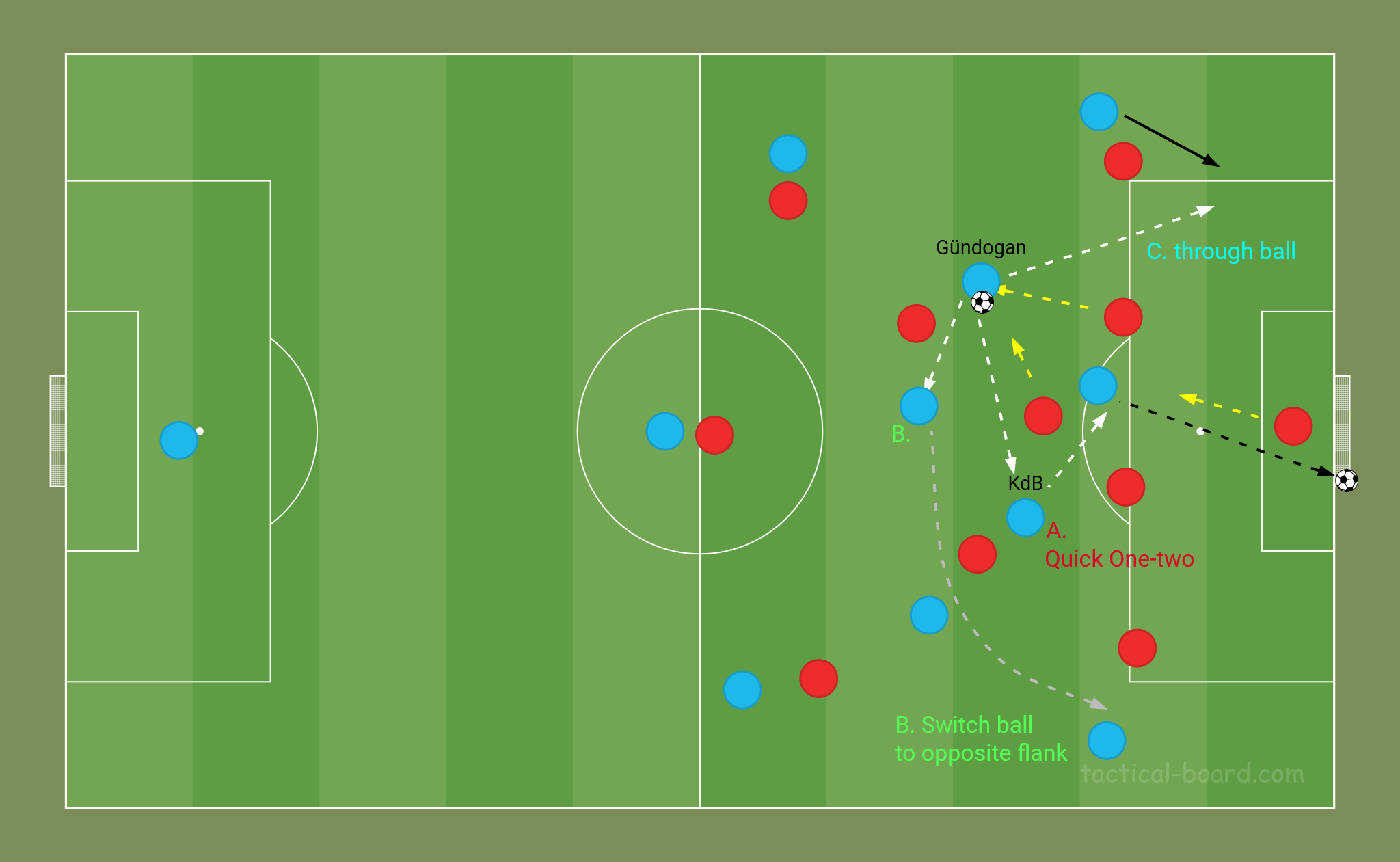
When Gündogan had possession of the ball, the number of passing options made the team enable to both maintain control of possession if gaps to penetrate didn’t arupt, or build an attack by progressing the ball forward.
For instance, if the opposing marker pushes out of his zone to close down Gündogan, the support from Kevin de Bruyne gave him the opportunity to play a quick one-two towards the right side of zone 14, and then onto Haaland who can make a first time shot, or carry the ball towards the goal before placing the shot at the back of the net.
These 3vs2 small sided scenarios summarizes most of the key principles to Pep Guardiola’s attacking football philosophy magnificently. When the team is in possession, it must abide to the rules of positional play to create numerous overloads, exploit the half spaces, have a lot of movement and vertical play that helps to come to goalscoring opportunities more effectively by creating weaknesses in the opposition’s defensive block that can be utilized effectively.
The movements of players combined with their positioning and duty enables the team to attack in multiple zones and channels at the same time – something that aims to dominate the opposition on their own half.
A brief insight to Gündogan’s and Kevin de Bruyne’s attacking contribution
The difference in duties of Gündogan and de Bruyne in possession is also seen in the statistics and how they are contributing to the team’s passing play. While de Bruyne is topping the chart for both shot-creating actions and goal-creating actions per 90 minutes, Gündogan doesn’t stand out in the statistics in a similar manner.
When Rodri makes the most progressive passes into the final third with 8.48 passes per game and de Bruyne making 3.51 passes into the penalty area per game, Gündogan makes slightly more passes into the final third than de Bruyne (4.72 vs 4.58).
Gündogan’s pass completion ratio is at 85.9% compared to Kevin de Bruyne’s 72.5%. This shows that he’s more likely to make short passes and combine with his closest teammates than de Bruyne who is mainly responsible for creating chances and delivering crosses into the penalty box.
So far, he has made the most crosses per game for Manchester City with 2.1 crosses per game.
This is a result of his positioning and body angle in the final third as he helps to overload on the right side and stay wide of the right half space channel to get enough space to pick out a pass – much similar to how Barcelona’s Pedri or Arsenal’s Martin Ødegaard operates in their respective sides attacking game.
Manchester City Out of Possession
A mantra for Pep Guardiola since the early days of his managerial career is that having the ball is the best form of defence. Over time he has used a lot of effort to find the ideal way to come up with the perfect system which is as solid at the back as it’s attacking potent.
Manchester City’s tactics is build around an aggressive way of defending where the focus is to try to regain possession as soon after the ball is lost. With numerical superiority around the ball zone it enables Manchester City to counter-press more effectively by trying to prevent counter-attacking initiatives by closing the opposing player on the ball as quickly as possible before he gets time and control to pick out a pass.
Attack and defence is the same thing. You defend well, you attack better. When you attack better you are more aggressive without the ball […]Pep Guardiola
This attacking way of defending is something Pep Guardiola had to make huge improvements upon when experiencing the quick transitions and the tempo Bundesliga teams had with their gegenpressing style when managing Bayern Münich. No longer could Pep Guardiola only consider pressing the opposition in their own half to regain possession quickly and swiftly, but also what happens to the team in the defensive transition if they are able to play it through to the striker or long to the opposite wing.
To stop the counter-attacks and that pin-ball machine like back and forth football where none of the teams are in control, Pep Guardiola had to look at how he could defend with the ball and how he could apply immediately pressure on the ball, if the ball is lost high up the pitch. and with acres of space to counter in due to the extremely high line Pep Guardiola favored at Barcelona.
The solution became positioning and compactness – as in the principles of positional play.
Manchester City’s defensive structures
Since his Barca days, Pep Guardiola has favored defending in a 4-1-4-1 shape. Over the years, as he has changed to both a 4-2-3-1 formation and the new 3-2-4-1 at Manchester City, which we are about to talk about, Pep Guardiola has started to defend in a 4-4-2 / 4-2-4 structure more often.
In my perspective, the 4-2-4 structure, together with the 4-2-3-1, is one of the best structures for pressing high. With a front four you’re able to create numerical superiority and thereby isolate the opposite defender when they are trying to build out from the back.
With a minor tweak to positioning, the team leading by the striker can force play into a specific area of the pitch by forcing the ball onto a defenders weak foot and thereby put pressure on the players on the left flank by staying in a man-to-man marking press with one of the central midfielders, or the striker, keeping control of the opposing defensive midfielder.
When it comes to Pep Guardiola and his Manchester City pressing tactics, which defensive formation he uses depends on whether the team press high or defend on their own defensive third.
Manchester City’s 4-4-2: The settled block
In the 4-4-2 mid to low block, the defensive midfielder (Stones) will drop in between the centre back and right fullback meanwhile the two wingers will drop deep and stay narrower.
The defensive tactics of Manchester City’s Pep Guardiola looks to apply the same principles as the ones they are trying to deal with in possession: congest the middle with a compact shape that makes it harder for the opposition to penetrate in as well as force the opposition down the flanks where it’s easier to set up a pressing trap – as the byline would act like a 12th man.

In a settled block, the tendency of Kevin de Bruyne to close down the opposing defender made the team seem like the team was defending in a 4-4-2 defensive structure.
Kevin de Bruyne would often follow de Ligt and force him to play it back to the goalkeeper when the team was in a mid-high block but could also press Upamecano if necessary. As soon as de Ligt received the ball, Kevin de Bruyne would push out of his position to force a back pass or a pass towards the wing where either Haaland or Silva could try to intercept the path of.
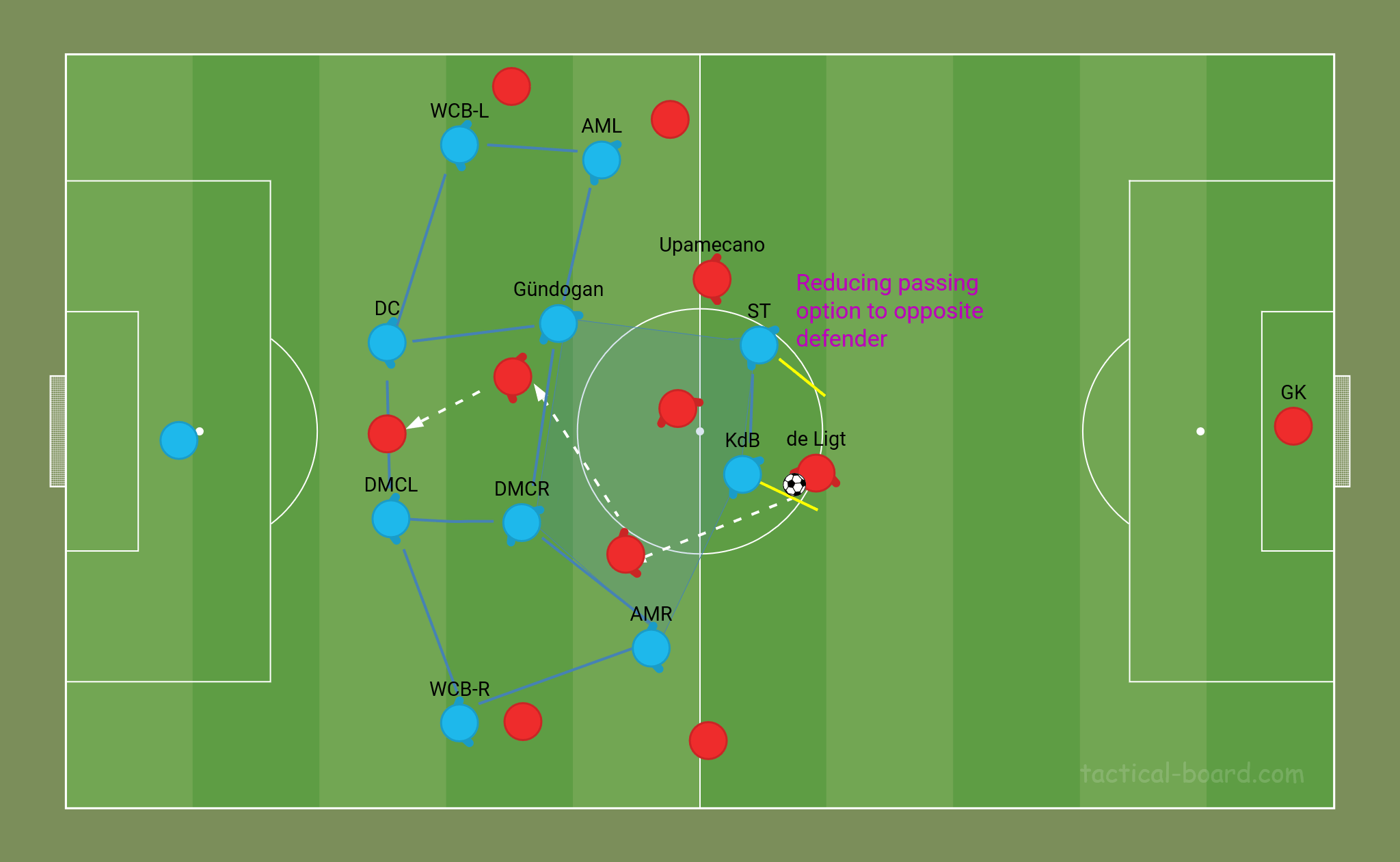
The 4-4-2 defensive structure enables the team to stay deep and remain compact between the lines.
With a box of four players in all channels, the positioning of the players can easily help to create defensive overloads by 4vs3 or 3vs2. This means that the opposition team has to become smarter and more creative in their positioning and movements to break through the lines – something that increases the risk of errors.
When defending in a 4-4-2 formation deep into their own half, Pep would normally ask the wingerst to tuck inside to create two lines of four with minimal space between eachother. Its aim is to force the opposition down the flanks rather than penetrat through the middle.
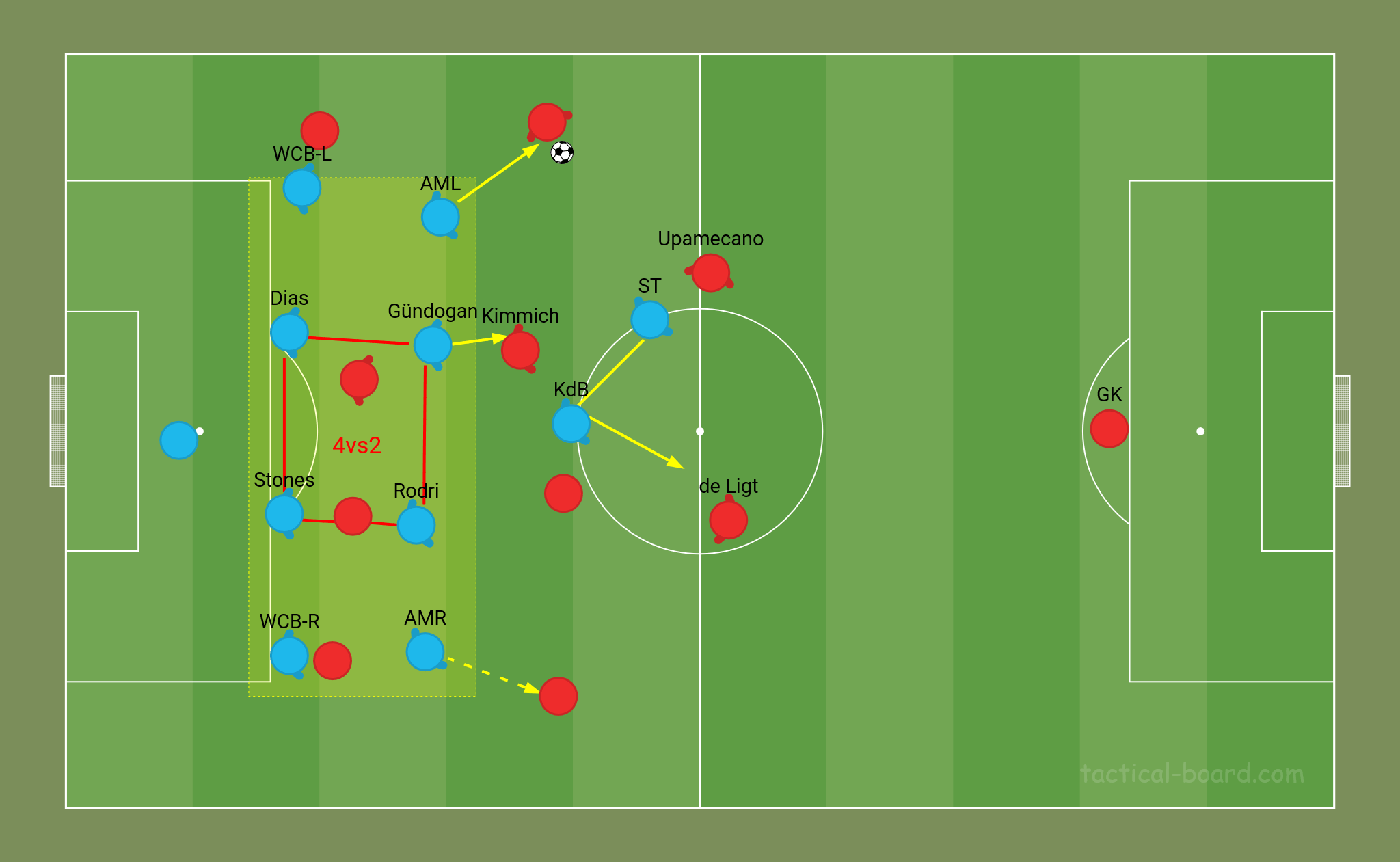
The roles of the striker and the second forward in these situations is simply to prevent the team to switch the ball from one flank to another more easily by keeping control of the opposing center back when they are in possession.
Hybrid Pressing
By moving from a four at the back with fullbacks or inverted wingbacks, the new 3-2-4-1 tactics of Manchester City is more aimed at winning possession high up the pitch than to defend in a low block. If they needs to defend for lengthy periods, the inverted wingers are instructed to keep control of the opposing fullback in order to avoid numerical superiority down the flanks and eventually overlaps.
Against Bayern Münich we saw clear examples of Pep Guardiola using hybrid pressing to avoid Tuchel’s men to advance play forward. With a 4-2-4 defensive structure, a lot of effort was used to disrupt Bayern’s build-up and limit the number of passing options for the ball carrier.
Hybrid pressing is essentially a mix between zonal marking and man-to-man marking.
To remain control out of possession, specific players had to man mark the opposing players in order to reduce the risk of being outnumbered. That meant that John Stones would need to keep control of the second forward (or attacking midfielder) to help Dias while the two inverted wingers had to man mark and follow the opposing fullbacks.

The role of the wide centre backs, or the fullbacks, in the 3-2-4-1 system is kind of special in the defensive transition phase, and when the team is counter-pressing. Since they are instructed to hold position rather than bomb forward to provide overlaps, their slightly deeper positions means they have to push up to support the high press when the team is chasing possession.
Most often, they will look to provide cover for the front three who are trying to close down the opposing player on the ball by moving into the back of the opposing winger to make it hard for him to gain control with them breathing down his neck.
The difference to Pep’s Barcelona and the counter-attacking weaknesses down the right flank with Daniel Alves acting like a fifth attacker is noticeable. Since Daniel Alves provided a defensive weakness down the right hand flank if he wasn’t able to recover into his defensive positioning, Pep Guardiola has found a new method to reduce the risk of getting caught on defensive transition with speed with his 3-2-5 shape where the fullbacks and double pivots create the necessary support and cover for the forwards to press man to man.
Man City’s 4-2-4 High Pressing Structure
In the 4-2-4 high press, Pep Guardiola instructed his players to close down Bayern’s left hand flank more often than on the right.
The front four of Pep Guardiola’s 4-2-4 high pressing structure was made up of Grealish, Haaland, Kevin de Bruyne, who acted as a second forward, and Silva.
To reduce the risk of Bayern progressing the ball out from the back with great success, Pep took advantage of Bernardo Silva’s workload and intensity to set immediate pressure on Alphonso Davies, meanwhile Kevin de Bruyne and Haaland closed down de Ligt and Upamecano.
In this system, the front two would focus on screening passing lanes in the middle and force the opposition down the flanks. The result was that it was one of the wingers who would be the first to apply pressure on the ball – ensuring the team could defend compact and remain solid between the lines.
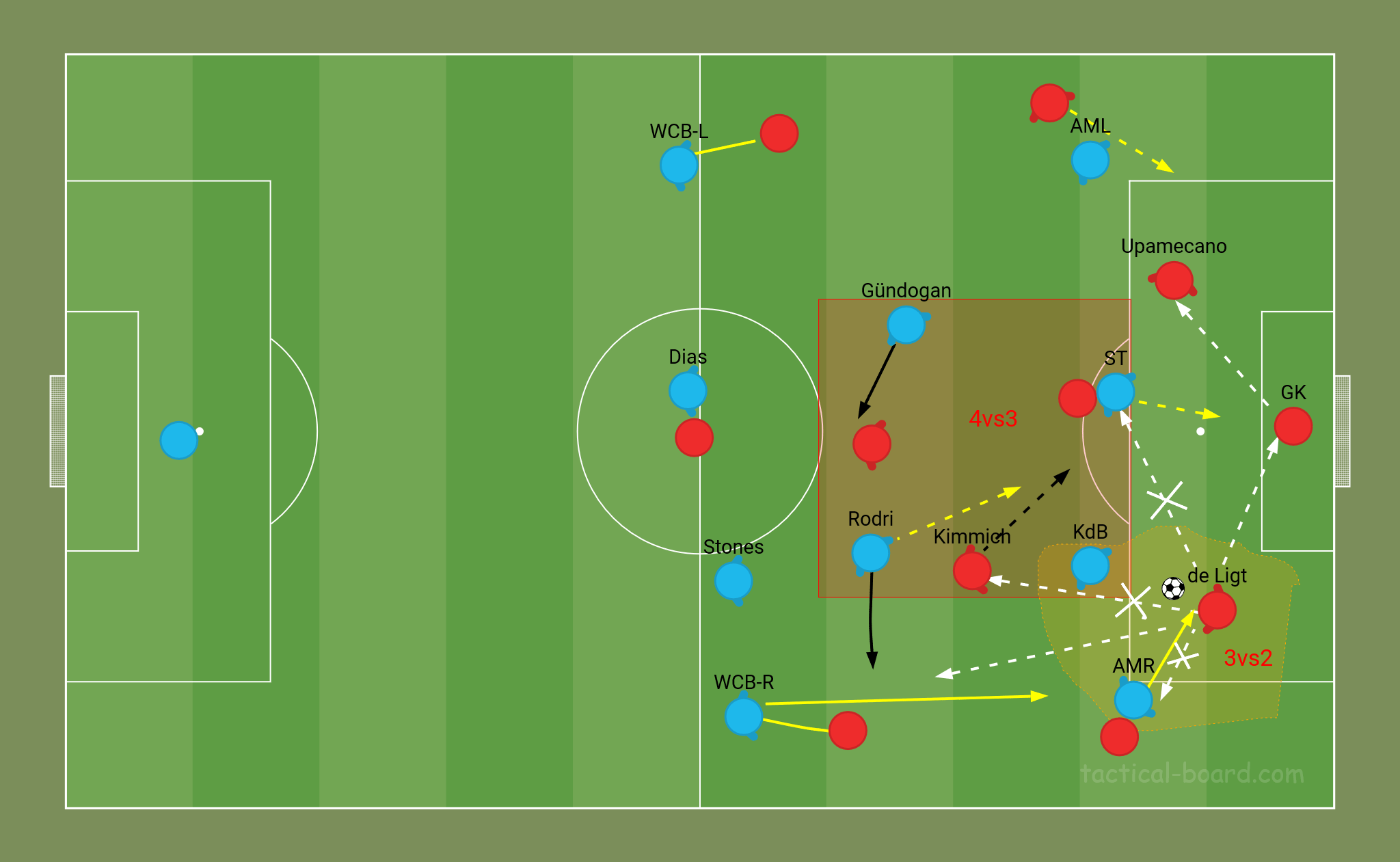
This illustration shows how the two forwards, Haaland and de Bruyne, provides the necessary defensive security in the middle, which reduces the chances of the opposition team to play their way out of defensive third through the middle, and at the same time gives the double pivot the chance to stay deeper and more compact to the central defenders.
When the front three of Silva, Haaland and Kevin de Bruyne was closing down and reducing the passing options for the player on the ball, Gündogan and Rodri would zonal mark the center of the pitch.
The deep positioning of the central midfielders protected the center from deep penetrating through balls, or longer counter-attacking moves to the strikers. By protecting the area behind the front four, Gündogan and Rodri was always able to try to recover second balls or cover for the forward’s pressing initative.
A few times, Rodri would step up from his defensive position to signalize for his front attackers to press higher. When that happened, he would also join the press by following the opposing defensive midfielder, Joshua Kimmich, trying to avoid Bayern to use him as an outlet in the build-up.
The result of Man City’s counter-pressing
The aggressiveness of Manchester City when Bayern, or any opposition team has the ball is another dimension to the success of Pep’s winning tactics. Here the work ethic of the pressing forward out of possession is as important to disrupt play and force errors as the tackling, positioning and ability to win the ball cleanly by Rodri and the fullbacks deeper on the pitch.
To summarize, how the front four apply pressure and who are applying the pressure first enables Manchester City to deny obvious passing options and force them to play the ball longer and into space as the closing down instructions stresses the opposition team in the build up in a manner that increases the chance of winning possession deeper on the field – perhaps from interceptions from Gündogan, Rodri, or one of the two fullbacks.
As a prime example, Rodri has made 2.1 tackles per game this season and won possession 1.2 times per game. Against Bayern, he won 8/10 ground duels and made 4 tackles. Bernardo Silva for instance, won 12 out of 23 ground duels and made 8 tackles. Not far away from Akanji’s 7 out of 11 ground duels won and 7 tackles.
These statistics not only proofs how great Manchester City are at winning possession down their right flank, but also how they were able to reduce the attacking threat of Bayern by aggressiveness, work ethic and strong tackles. The result was an abysmal average rating of eblow 6 for both Alphonso Davies and Upamecano.
NB! The match against Bayern represents a game out of the ordinary for Manchester City. Not only had they less possession than the opposition as the game became a ping-pong match, no other matches has the team won more tackles in the attacking third, and in overall than in the first leg of the UEFA Champions League quarter finals. But the high press paid off.
The Weakness of the 3-2-4-1
Every formation has its pros and cons. While Pep Guardiola’s Man City tactics enables the team to overload the opposition in the final third with a 3-2-5 shape and create numerical superiority in the middle with a box midfield, especially when coming up against a 4-3-3.
Despite the intent on surrounding the opponent by having players positioning close together, so if the ball is lost it’s easier to regain it, the 3-2-4-1 system has it’s flaws out of possession. One of them is the space behind the wingers and the increased likeliness to set up overlaps down the flanks.
However, when coming up against the 4-2-3-1, Tuchel and Bayern Münich was able to counter the 3-2-4-1 in some ways. For the first time in years, Pep Guardiola went off the field with less possession than his opponent – 44% to 56%.
The concept of using 5 forwards results in an higher need to do the defending higher up. While the 3-2 defensive structure at the back helps to protect all the five channels against counter-attacks it puts more emphasize on the need of the wingers to contribute to more defensive actions.
For instance, Bernardo Silva was the desired player at right flank due to his top notch work load and ability to press the opposing fullback and centre back for the entire 90 minutes.
But if possession isn’t won high up the field, Man City needs to move into a defensive block very quickly. That means Stones moving back into the defensive line as the fourth centre back, and the front line retreating into a 4-4-2 shape.

As we saw time and time again, Jamal Musiala (AMC) received huge acres of space between the lines to work his magic. Even though it did not result in any goals, there were major chances that could have changed the 3-2-4-1 from a winning tactics into another 200IQ failure.
The new system requires man to man marking at specific positions to reduce the vulnerable space. Wingers needs to man mark and follow the wingers in order to avoid 2vs1 situations down the wide channels.
Stones needs to either man mark the AMC, one of the wingers, or one of the strikers, to free up the responsibilities of Aké and Akanji, so they can track the opposing winger (Sané and Coman), or defend the channels on either side of Dias who will often stay one on one against the opposing forward.
If they don’t track back the opposing team will easily create overloads down the flank.
The use of five up front increases the risk of quick turnovers in the large space behind Gündogan and Kevin de Bruyne in the half space.
At the same time, if faced with quick wingers like Sané the positioning of the wide centre-backs in the build-up can risk the opposing team trying to focus their play down the flanks and win possession by closing down the wide centre-backs when they are in possession by reducing the number of available passes, resulting in an opportunity to come clean on goal with only the goalkeeper to beat.
For it to work, you need players who are disciplined, got great awareness and is composed with the ball at their feet.
Our tactical analysis of Pep Guardiolas Manchester City tactics and the insight to Pep’s new 3-2-4-1 formation provides a great foundation before looking at how we recreate Pep Guardiola’s Manchester City 2022/23 tactics in Football Manager 2023.
In chapter two, we take a closer look at the FM23 Pep Guardiola Manchester City 3-2-4-1 tactic and how to play like Pep Guardiola in Fotball Manager 2023.
Download FM24 Pep Guardiola’s Man City Tactics
The Football Manager 2024 Pep Guardiola’s Manchester City tactics is here!
Enter the world of Pep Guardiola’s mastermind. Play the new football meta in Football Manager 2024 with Passion4FM’s replication of Pep Guardiola’s Manchester City 3-2-4-1 tactics from 2022/23 season, or play with the traditional Pep Guardiola 4-3-3 tactic in FM23.
Released: 07.06.2023 – FM23 DOWNLOAD
Updated: 26.11.2023 (For Football Manager 2024)


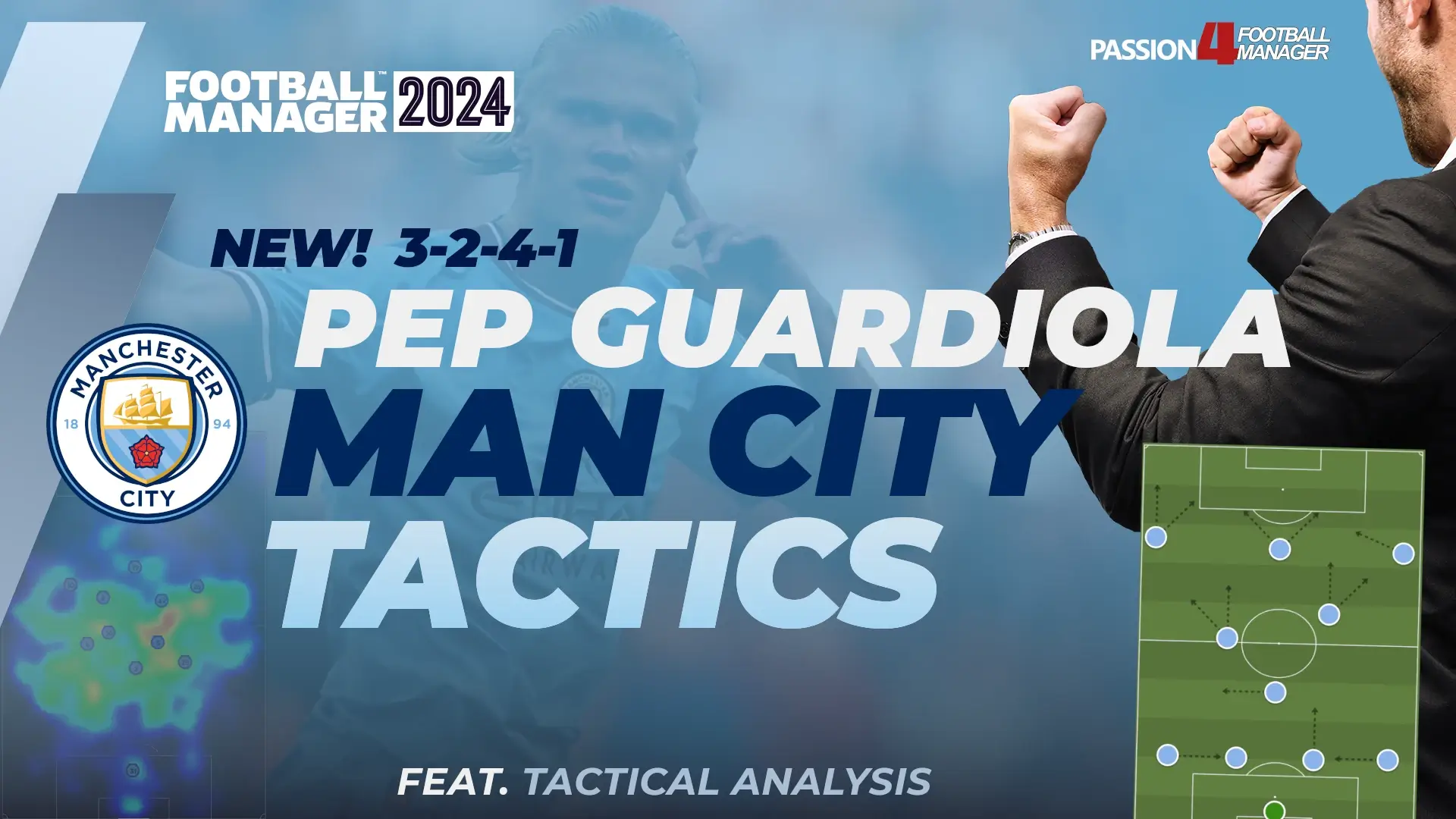
20 Comments
The latest tactic in FM24 doesn't work, it has a lot of possession but creates almost nothing. Could you update it
Sorry to hear about that! I won't take time to update the tactic now as I have my hands full with other projects – unfortunately!
hi espen, do you think this tactic works with the winter update too? or are you working on other solutions?
Hi, I read that there was an update on March 6, 2024, what's new? Are you by any chance preparing new content for when the new update is available?
Thank you
No other update than some page speed fixes
Hi, Will the training schedules be updated to use for this? The megapack doesn't seem to work on this year's version and they've been excellent for the last couple of fms. Thanks
Hi, the work on training schedules has started! Just a major job testing them out and trying to make them effective! hopefully out soon!
atualizou para o FM 24 ??
I'm trying the tactic and I don't think it works at its best. I have a lot of possession (sometimes even reaching 70%) but I make few shots on goal and create very few opportunities. Is this due to the level of my team? or do I need to do something to improve?
alternatively, can I continue to use the 2-3-5 of fm 2023 on the save of fm 2024? Thank you
The new 24.2 ME seems to reduce the number of chances and goals slightly.. But your question is impossible to answer without any more flesh to the bone. I can't give you an appropriate answer without more information. As you probably know, everything depends on your players abilities, your form, squad morale, team cohesion (dynamics), the opposition and their shape and playing style and last but not least training schedules appropriate to the tactics. Now, you will probably ask for my training schedules megapack and think that's the answer or that it's solely the tactics fault… but the answer can be a mix of everything. It's like asking me why it's raining today. However, I do believe the Match Engine is 10% of the answer. If you give me some more information, then it would be easier to investigate. Atm I believe I spent more time updating past content than releasing new which is really demotivating..I will probably do some testing with this tactic for 24.2 ME but it's not first on my priority list as I wish to release new content as well
you're right, sorry, I play with Lazio and I let young players play, I don't use specific training, I let the staff manage them. Are you saying I could use the training magapack you released for Barca's tactics? also, do you have any advice for me on how to make the most of this tactic?
If I may ask, what tactics would you plan to emulate?
Thank you for your patience and for the time you take to answer me!!
I have created a similar tactic since the release of FM 24 Beta that produced amazing results for me personally, but the overall performance has dropped after 24.2. I create slightly less chances than I used to and I've noticed that also my strikers miss some very easy to score chances, especially in the area.
Now, obviously to get the most out of such tactics, you would need to have a very good roster or, be the best club in your country. Lazio is not such. What you also need to consider is, Serie A, is a primarily defensive minded league, and they focus a lot on tactics with 3 at the back which are extremely hard to break when you don't have an elite squad.
In FM 24, more than any other FM, you have to make some adjustments in game after observing how the opponents play against you and how they press you. Against easier sides, do not be afraid to go a bit more attacking and even increase the tempo/pass range a bit. I do believe however that especially in FM 24, Dribble Less kills creativity for the sake of having more passes. So I would try to avoid it if possible.
Also as Espen said, your players will need some time to adjust to a new tactic, especially if they are new to this or the roles are unknown to them (or them being unsuited for the roles). Usually you'll notice better results after the first 1-2 seasons as your team learns the tactic and you improve the roster!
Hope this helps a bit.
The case about tactical familiarity is very important. If a team usually prefers a 3-4-2-1 formation it would take ages to make the team capable of playing a 4-3-3 formation. On top of it, the Pep tactics isn't suitable for any teams as you need the right players. Dribble Less has been ticked to increase the number of passes simply because some people want to see more than 600 passes per game and more one-two's or quick short passes. In my coming Barcelona Tiki-Taka tactic it's taken off.
thanks for the advice, I will use the City players as a reference to improve the team. Do you have any advice on who to buy?
Bro when you releasing it
any idea when this will be released? a time frame?
When is it coming out? I'm so excited i've literally been checking every day lmao.
Hi, I read that the 4-3-3 that was used by the city was also found in the package, right?
I wanted to ask you if, even for this tactic, you have to incorporate a training program like the ones it was recommended to use for Barça's tactics
Thanks, I look forward to the new tactics
When will the Tactic Dowlods be released?
Hopefully soon! Unfortunately haven't had time to work on it as I had imagined.